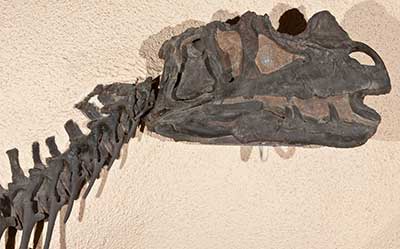Ceratosaurus
(sir-AT-oh-sore-us)
| Quick Facts | |
|---|---|
| Name Meaning: | Horned Lizard |
| Distribution: | Colorado, Utah, Wyoming, USA; Africa |
| Time Period: | Late Jurassic, 150 Ma |
| Length: | 20 ft (6 m) |
| Weight: | 1 tons |
| Diet: | Carnivore |
| Linnaean Classification | |
| Kingdom: | Animalia |
| Phylum: | Chordata |
| Class: | Reptilia |
| Superorder: | Dinosauria |
| Order: | Saurischia |
| Suborder: | Theropoda |
| Infraorder: | Ceratosauria |
| Family: | Ceratosauridae |
| Genus: | Ceratosaurus |
| Cladistic Classification | |
| |

History
The Ceratosaurus was discovered in the Cleveland Lloyd Dinosaur Quarry in Utah, among many Allosaurus, as well as the Dry Mesa Quarry in Colorado. It was described by O. C. Marsh in 1884 and then redescribed in 1920. Several more species were discovered and described in 2000.Description
The Ceratosaurus lived in the Jurassic period at the same time as its biggest rival the Allosaurus. Although smaller than the Allosaurus it was a deadly predator. Its slightly elongated head was large for the dinosaurs size and bore long curved teeth like knives. Like many other predators it was bipedal with large muscular legs and short arms. It receives its name from the small horn on its snout as well as the two smaller horns above each eye. The tail was rather stiff and fused so that only the back half of the tail could move.Lifestyle
It has been determined, due to recent limb studies that the Ceratosaurus was probably a sprinter, putting on short bursts of speed to overtake its prey. It may also have been a good swimmer due to the crocodilian-like tail, making fish a likely diet. However, it may also have taken down larger prey like the Stegosaurus, or on the young of larger dinosaurs. Currently there is no fossil evidence that the Ceratosaurus hunted in packs. The specimens discovered in Cleveland Lloyd Dinosaur Quarry were considerably more rare than the many Allosaurus specimens found at that site. The males appeared to be stronger and more agile than the females. The horn may have been used for combat; however, it was more likely used as a display or a way of competing with other males of its kind.
ScienceViews Writer: Jason Hamilton.
Copyright © 2005-2010 Calvin & Rosanna Hamilton. All rights reserved.